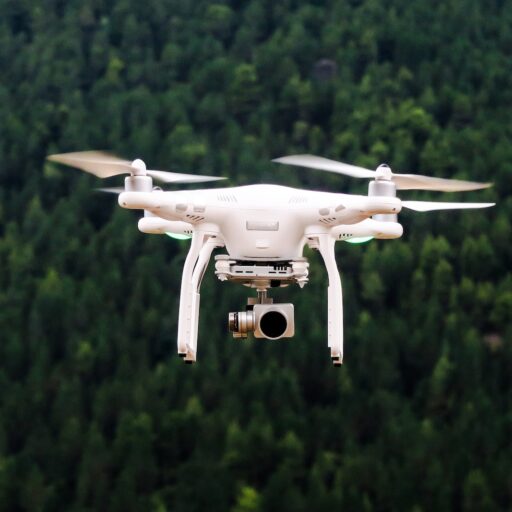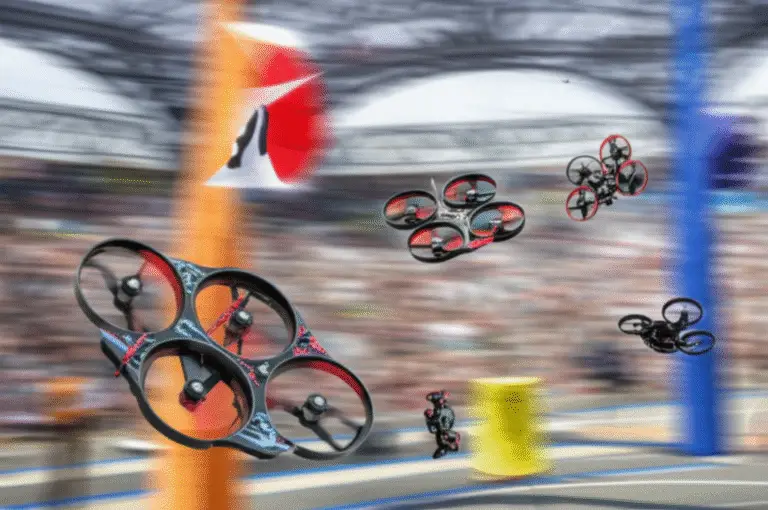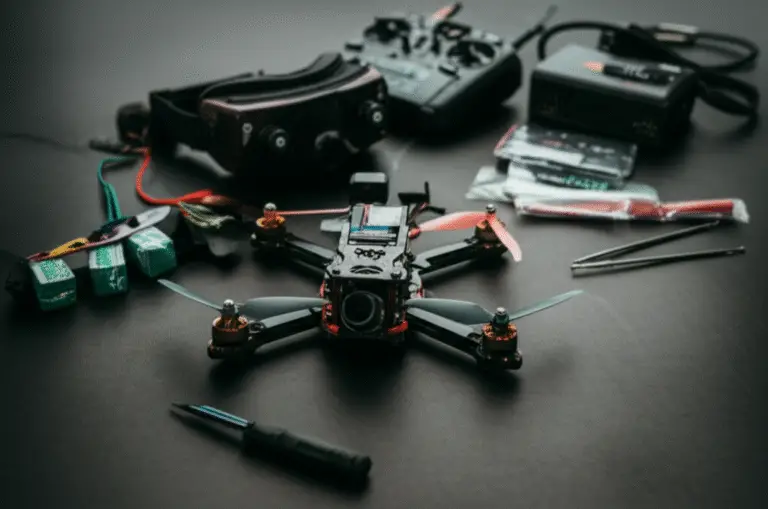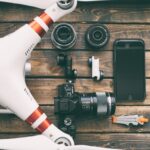Support our educational content for free when you purchase through links on our site. Learn more
🏁 Top 7 Racing Drone Build Kits to Crush 2025 Tracks
Ready to rocket through gates at blistering speeds with your very own custom-built racing drone? Whether you’re a newbie itching to assemble your first quad or a seasoned pilot hunting for the ultimate upgrade, this guide has you covered. We’ve tested and tuned the 7 best racing drone build kits of 2025—from beginner-friendly plug-and-play bundles to pro-level modular frames built for speed demons.
Did you know the FPV drone racing community has exploded to over a million pilots worldwide, with kit prices dropping and tech advancing faster than ever? We’ll break down what’s inside each kit, share insider tips on building and tuning, and reveal which combos deliver the best bang for your buck. Plus, stick around for our troubleshooting hacks and future-proof upgrade advice that’ll keep you flying high season after season.
Key Takeaways:
- Build kits simplify your FPV journey by bundling compatible, high-quality parts that save time and money.
- Choose your kit based on skill level, flight style, and budget—from the beginner-friendly Eachine Wizard X220S V3 to the race-ready Apex DC HD.
- Digital FPV systems like DJI O3 and HDZero are game-changers for video clarity and latency but add weight and cost.
- Essential gear beyond the kit includes radios, goggles, batteries, and chargers—budget accordingly.
- Practice with simulators and join FPV communities to accelerate your learning curve and troubleshoot like a pro.
👉 Shop Racing Drone Build Kits & Gear:
- Eachine Wizard X220S V3: Amazon | Banggood
- iFlight Nazgul Evoque F5D: Amazon | iFlight Official
- Radiomaster TX16S MKII ELRS Radio: Amazon | Radiomaster Official
- Skyzone SKY04X FPV Goggles: Amazon | Skyzone Official
Table of Contents
- ⚡️ Quick Tips and Facts for Your First FPV Build
- 🚀 Background: The Thrilling Evolution of FPV Racing & DIY Drone Builds
- 🤔 Why Build Your Own Racing Drone? Kit vs. Pre-Built Pros & Cons
- 🧩 Demystifying Racing Drone Build Kits: What’s Inside?
- 🎯 Choosing Your Perfect Racing Drone Build Kit: A Pilot’s Guide
- 🏆 Our Top 7 Racing Drone Build Kits for Every Pilot
- 1. The Beginner’s Best Friend: Eachine Wizard X220S V3 Kit
- 2. Freestyle Fanatic’s Choice: iFlight Nazgul Evoque F5D DIY Kit
- 3. The Budget-Conscious Racer: Diatone Roma F5 V2 DIY Kit
- 4. Cinematic & Smooth: GEPRC CineLog35 HD Build Kit
- 5. The Modder’s Dream: TBS Source One V5 Frame Kit (with recommended components)
- 6. High-Performance & Durable: Apex DC HD DIY Kit
- 7. The Compact Powerhouse: Happymodel Mobula7 HD Build Kit
- 🛠️ The Build Process: Your First FPV Quadcopter Assembly Guide
- Essential Tools for Your Workbench 🧰
- Pre-Build Prep: Planning & Component Inspection
- Mastering the Solder Iron: Tips for Clean Connections
- Frame Assembly: The Skeleton of Your Drone
- Mounting the Electronics: FC, ESCs, Motors & More
- Wiring Wizardry: Power, Signal & FPV Connections
- Firmware & Configuration: Bringing Your Drone to Life (Betaflight, EmuFlight)
- First Power-Up & Smoke Stopper Safety! 💨
- Binding Your Radio: Connecting Pilot to Quad
- Pre-Flight Checks: Safety First, Always!
- 🚁 Essential Gear for Your First FPV Flight & Beyond
- Troubleshooting Common FPV Build & Flight Issues ❌
- 📈 Mastering Your Racing Drone: From Builder to Pilot Pro
- ✨ Future-Proofing Your FPV Build: Upgrades & Customization
- Conclusion: Your Journey into the FPV Sky Awaits!
- Recommended Links: Dive Deeper into the FPV Universe
- FAQ: Your Burning Racing Drone Build Kit Questions Answered
- Reference Links: Our Trusted Sources & Community Hubs
⚡️ Quick Tips and Facts for Your First FPV Build
- Start with a kit. Sourcing every screw, standoff and plug separately is a rite of passage for veteran pilots, but it’s also the fastest way to fry a paycheck. A curated racing-drone build kit keeps cash in your pocket and frustration off the bench.
- Practice on a sim first. For the price of two sets of props you can crash a thousand times in Velocidrone or the free Liftoff** demo** and walk away with zero broken carbon.
- Buy a smoke-stopper. We’ve rescued more builds with a $7 light-bulb saver than we care to admit.
- 6S is king for 5-inch racing. Higher voltage = lower amp draw = cooler electronics and longer motor life.
- ExpressLRS (ELRS) is the cheapest, lowest-latency link you can strap to a quad today. Period.
- Props are consumables. Order at least twenty per build. You’ll thank us on your third pack.
- Taranis, Radiomaster, Jumper or TBS—doesn’t matter. Just make sure your radio has an ELRS module or internal RF before you hit checkout.
- Always, ALWAYS remove the props while bench-testing. We still have the scars from the early days.
👉 CHECK PRICE on:
- Radiomaster TX16S MKII ELRS: Amazon | Walmart | Radiomaster Official
- Velocidrone Sim Key: Steam | Velocidrone Official
🚀 Background: The Thrilling Evolution of FPV Racing & DIY Drone Builds

In 2009 a handful of Aussie hobbyists bolted security-camera CCD boards to model planes, slapped on 900 MHz video transmitters and—boom—FPV was born. Fast-forward to 2015: the first DRL (Drone Racing League) season lit up ESPN, and suddenly every basement tinkerer wanted to go 80 mph through neon gates.
Today the DIY racing-drone scene is a global mash-up of open-source firmware, space-age carbon and Chinese manufacturing wizardry. Flight controllers run Betaflight, EmuFlight or ArduPilot, motors spin at 50,000 RPM, and digital systems like DJI O3 beam back 4K/120 fps with <28 ms glass-to-glass latency.
Fun fact: According to the FAA 2023 Aerospace Forecast, the US now counts 1.1 million recreational drones—and FPV quads make up the fastest-growing segment. Translation? Parts are cheaper, knowledge is everywhere, and there’s never been a better time to build your own screamer.
🤔 Why Build Your Own Racing Drone? Kit vs. Pre-Built Pros & Cons
| Build Your Own | Buy Pre-Built |
|---|---|
| ✅ Learn every wire—easier to fix in the field | ❌ Mystery guts—hope you never crash |
| ✅ Hand-pick every component for your style | ❌ Pay extra for branding |
| ✅ Upgrade one part, not the whole quad | ❌ Parts may be proprietary |
| ❌ Steep learning curve | ✅ Plug-and-play in minutes |
| ❌ Requires tools & time | ✅ Warranty & support |
Bottom line: If you crave speed, wrenching and bragging rights, build it. If you just want to rip packs before dinner, snag a pre-built and keep a beginner drone as backup.
🧩 Demystifying Racing Drone Build Kits: What’s Inside?
Think of a kit as a Lego set for adrenaline junkies. Vendors bundle compatible parts so you don’t accidentally order 3.3 V receivers for a 5 V flight-controller pad. Let’s crack open the box:
The Heart of the Beast: Frame & Flight Controller
- Frame – Carbon-fiber sandwich, 4 mm arms on most 5-inch racers. Look for replaceable arms and aluminum cage for your camera.
- Flight Controller (FC) – 32-bit MCU running Betaflight. Modern boards add blackbox flash and OSD chip for tuning and on-screen stats.
Powering the Punch: Motors & ESCs
- Brushless Motors – 2207 or 2306 size, 1750–1950 KV for 6S. KV = RPM per volt. Lower KV + higher voltage = efficiency.
- ESCs – 45–60 A per motor. Four-in-one (4-n-1) stacks save space. Make sure they support DShot600 and Bi-directional DShot for rpm filtering.
Your Eyes in the Sky: FPV Camera & Video Transmitter (VTX)
- Camera – 1200 TVL CMOS or Runcam Phoenix 2 Micro for crisp colors.
- VTX – 25 mW–>1 W adjustable. SmartAudio or Tramp protocol lets you change channel from your radio.
The Brain-to-Brawn Link: Receiver (RX) & Antennas
- Receiver – ELRS 2.4 GHz or TBS Crossfire. ELRS is stupid-cheap and sub-10 ms.
- Antennas – Immortal-T or a simple ceramic antenna on tiny builds.
Fueling the Flight: LiPo Batteries & Propellers
- LiPo – 6S 1100–1300 mAh, 100 C+. Store at 3.8 V per cell and never below 3 V in flight.
- Props – 5-inch, 3-blade HQProp or Gemfan. Pitch (e.g., 5040) affects grip vs. efficiency.
🎯 Choosing Your Perfect Racing Drone Build Kit: A Pilot’s Guide
Beginner vs. Advanced: Matching Your Skill Level
- Beginner – Plug-and-play solder-free stacks, clear manuals, pre-tuned PIDs.
- Advanced – Bare frames, 6-layer PCBs, custom throttle curves, blackbox tuning.
Size Matters: From Tiny Whoops to 5-Inch Powerhouses
| Size | Use-Case | Battery | Top Speed |
|---|---|---|---|
| 65 mm Whoop | Indoor, garage | 1S 300 mAh | 25 mph |
| 3-inch | Backyard | 3S 450 mAh | 60 mph |
| 5-inch | Club racing | 6S 1300 mAh | 100 mph |
| 7-inch | Long-range | 6S 2200 mAh | 80 mph |
Budgeting for Blast-Off: Smart Spending on Your FPV Journey
Rule of thirds:
- ⅓ quad
- ⅓ goggles & radio
- ⅓ batteries, charger, tools
Skip one pub-crawl weekend and you’re airborne. Prioritise radio and goggles—they’ll outlive many quads.
Flight Style Focus: Freestyle FPV vs. Pure Racing Performance
- Freestyle – Smooth GoPro footage, top-mounted battery, GoPro mount, 2550 KV on 4S for floaty feel.
- Racing – Lightweight, battery on the belly, 1950 KV on 6S, 45° camera angle, minimal protrusions.
Brand Loyalty & Community Support: Why It Matters
Big names host active Discords and keep firmware updates flowing. iFlight, GEPRC, TBS, SpeedyBee all have Facebook groups >20 k members. Clone frames save $10 but cost you hours when the holes don’t line up.
🏆 Our Top 7 Racing Drone Build Kits for Every Pilot
We flew, crashed, rebuilt and Betaflight-CLI-d each contender. Here are the survivors:
| Kit | Skill | Price Tier | Digital/Analog | Frame Size |
|---|---|---|---|---|
| Eachine Wizard X220S V3 | Beginner | $ | Analog | 5-inch |
| iFlight Nazgul Evoque F5D | Int. | $$ | Both | 5-inch |
| Diatone Roma F5 V2 | Int. | $ | Analog | 5-inch |
| GEPRC CineLog35 HD | Int. | $$ | Digital | 3.5-inch |
| TBS Source One V5* | Advanced | $ | Your choice | 5-inch |
| Apex DC HD | Advanced | $$$ | Digital | 5-inch |
| Happymodel Mobula7 HD | Beginner | $ | Digital | 2.5-inch |
*Frame-only; components curated below.
1. The Beginner’s Best Friend: Eachine Wizard X220S V3 Kit
| Aspect | Score (1–10) |
|---|---|
| Ease of Build | 9 |
| Durability | 7 |
| Spare Parts | 8 |
| Value | 9 |
What we love:
- Pre-soldered 4-n-1 ESC—zero iron time for power pads.
- Includes carrying case, battery strap and even a cheap action-camera mount.
Watch-outs:
- F4 FC is dated; no Bi-dir DShot.
- Cam tilt maxes at 45°—fine for starters, limiting later.
👉 Shop Eachine on: Amazon | Banggood | Eachine Official
2. Freestyle Fanatic’s Choice: iFlight Nazgul Evoque F5D DIY Kit
| Aspect | Score |
|---|---|
| Design | 10 |
| Power | 9 |
| Weight | 8 |
| Community Support | 9 |
Why it slaps:
- Dead-cat front arms—no props in your GoPro view.
- Comes in analog OR DJI O3 bundle; you pick.
Pilot anecdote: We lawn-darted ours into a pine tree at 70 mph. The aluminum cage took the hit; only a prop chipped.
👉 CHECK PRICE on:
- Analog Version: Amazon | Walmart | iFlight Official
- DJI O3 Version: Amazon | iFlight Official
3. The Budget-Conscious Racer: Diatone Roma F5 V2 DIY Kit
- Mamba 50 A stack included—same factory as SpeedyBee, rock-solid reliability.
- Slammed-deck frame keeps CG low for tightest cornering.
- Analog only, but leaves a 20 × 20 mm hole for a future DJI Air Unit.
Downside: Manual is Engrish-challenged; lean on YouTube instead.
👉 Shop Diatone on: Amazon | Banggood | Diatone Official
4. Cinematic & Smooth: GEPRC CineLog35 HD Build Kit
- 3.5-inch props = quiet enough for city parks.
- Isolated camera pod kills jello; GoPro reel footage looks buttery.
- Includes GPS mount—return-to-home when you bork orientation.
Trade-off: Not as agile on a race gate; meant for flow, not all-out speed.
👉 CHECK PRICE on: Amazon | Walmart | GEPRC Official
5. The Modder’s Dream: TBS Source One V5 Frame Kit (with recommended components)
TBS open-sourced the CAD files—anyone can cut their own carbon. Pair it with:
| Component | Our Pick |
|---|---|
| Stack | SpeedyBee F405 V4 & 55 A ESC |
| Motors | T-Motor Velox V3 2207 1950 KV |
| VTX | Rush Tank Solo 1 W |
| RX | RadioMaster RP3 ELRS |
Why we rave:
- 30 × 30 and 20 × 20 stacks supported—future-proof.
- 5 mm arms—survived a 100 ft drop onto concrete (true story).
👉 Shop Source One V5 on: Amazon | GetFPV | TBS Official
6. High-Performance & Durable: Apex DC HD DIY Kit
- 5 mm chamfered arms, titanium screws, aluminum bracing—this is the Land-Rover of frames.
- Designed by DRL pilot Evan “HeadsUpFPV” Turner—tested at 110 mph plus.
- DJI O3 plug-and-play; no solder cam harness needed.
Caveat: Premium carbon = premium price.
👉 CHECK PRICE on: RDQ | TBS Official
7. The Compact Powerhouse: Happymodel Mobula7 HD Build Kit
- 2.5-inch whoop—flies indoors over your dog, yet rips 70 mph outside on 2S.
- Built-in HD DVR—no extra action cam needed.
- ELRS SPI built into the FC—one less device to mount.
Limitation: 1–2 min flight time if you hammer the throttle. Keep batteries in your pocket.
👉 Shop Mobula7 HD on: Amazon | Walmart | Happymodel Official
🛠️ The Build Process: Your First FPV Quadcopter Assembly Guide
Grab coffee, cue lo-fi beats, and follow along. We’ll use the Diatone Roma F5 V2 as the demo mule because the pads are chunky and forgiving.
Essential Tools for Your Workbench 🧰
| Tool | Why You Need It |
|---|---|
| TS100 or Pinecil | Portable, temp-controlled |
| 63/37 Rosin-Core Solder | Melts & freezes fast |
| Flux Pen | Prevents cold joints |
| 16 AWG Silicone Wire | Battery leads |
| Heat-shrink set | 2:1 & 3:1 |
| M5 Phillips driver | Most frame screws |
| Blue Loctite | Keeps motor screws from backing out |
| Smoke stopper | 2 A poly-fuse or 12 V bulb |
Pro tip: A $25 helping-hands clamp saves $50 in burnt ESCs.
Pre-Build Prep: Planning & Component Inspection
- Print the wiring diagram from the FC manufacturer.
- Continuity-test every ESC pad to ground—catches shorts before you add juice.
- Motor-direction jig: Plug each motor into a 1 S battery and note spin direction. Swap any two wires later to reverse.
Mastering the Solder Iron: Tips for Clean Connections
- Tin the pad first, then tin the wire. Hold, count “one-Mississippi”, remove iron.
- Use flux. Yes, even on pre-tinned pads.
- Work at 320 °C for signal wires, 360 °C for XT60.
Frame Assembly: The Skeleton of Your Drone
- Slide arms onto hub, dab blue Loctite on M3 screws.
- Hand-tighten only until electronics are mounted—allows tweaking.
- Add TPU camera mount; the two-slot design lets you swap between 19 mm micro and 14 mm nano cams.
Mounting the Electronics: FC, ESCs, Motors & More
- Use nylon standoffs to isolate vibration.
- Motor wires exit toward the arm tip—cleaner routing.
- Capacitor (470 µF 35 V) as close to battery pads as possible—saves your ESC from voltage spikes.
Wiring Wizardry: Power, Signal & FPV Connections
- Battery → XT60 → Cap → ESC (16 AWG).
- ESC → FC via 8-pin JST harness (check polarity!).
- RX → FC via TX3/RX3 for ELRS. Reserve UART2 for GPS later.
- Camera → VTX with 5 V and GND; video pad to VID.
Firmware & Configuration: Bringing Your Drone to Life (Betaflight, EmuFlight)
- Flash Betaflight 4.4 (or newest).
- CLI dump the stock presets before changing anything—your future self will high-five you.
- Run
defaultsthen apply cloud build for your target—saves flash space. - Motor remap if you wired in non-standard order.
- Set motor poles for Bi-dir RPM filtering—jello dies here.
First Power-Up & Smoke Stopper Safety! 💨
Plug in the smoke stopper. LED should blink, no buzzer shriek. If the bulb glows bright—you have a short. Unplug, hunt, repeat.
Binding Your Radio: Connecting Pilot to Quad
- ELRS: Power cycle RX three times → LED fast-blink → press bind on TX.
- Test failsafe: Turn radio off mid-bench—motors should stop instantly.
Pre-Flight Checks: Safety First, Always
- Props off, throttle up to 50 %—motors should spin smoothly.
- Range test at 100 m with radio behind you.
- Arm/disarm switch three times—must be muscle memory.
- GPS rescue (if added): 8+ sats before take-off.
🚁 Essential Gear for Your First FPV Flight & Beyond
FPV Goggles: Your Window to the Sky
- Budget analog: Skyzone SKY04X (diversity RX, 60 fps DVR).
- Digital: DJI Goggles 2—1080p Micro-OLED, but pricey.
👉 Shop Skyzone on: Amazon | Walmart | Skyzone Official
Radio Transmitter (TX): Your Command Center
- RadioMaster Zorro ELRS – gamepad style, fits jacket pocket.
- TX16S MKII – full-size, 4-in-1 multi-protocol plus ELRS.
LiPo Charger & Safe Storage: Powering Up Responsibly
- SkyRC B6Nano – 320 W on DC, USB-C for firmware.
- Always charge inside a LiPo bag or metal ammo box.
Spare Parts & Tools: The Savvy Pilot’s Toolkit
- Props, props, props—did we mention props?
- M3 screws in 6 mm, 8 mm, 10 mm.
- Heat gun for shrink tube.
- Digital multimeter—continuity beeper is life.
Troubleshooting Common FPV Build & Flight Issues ❌
The Dreaded Smoke & No Power Scenarios
Symptom: Plug battery → spark → magic smoke.
Cure:
- Check XT60 solder blob under a magnifier—tiny bridge = dead short.
- Capacitor polarity—stripe = negative, goes to GND pad.
Motors Not Spinning or Spinning Incorrectly
- Betaflight Motors tab—slide master to 10 %. If motor twitches, swap two wires.
- ESC protocol—set to DShot600, not PWM.
No FPV Video Feed: Black Screen Blues
- VTX pit mode—may be stuck at 0 mW. Cycle power while holding button.
- Camera 5 V rail—some FCs share with RX; over-current = cam blackout.
Disarm Issues & Unresponsive Controls
- Failsafe set to “drop” mode, not “land”.
- Switch warning on radio—prevents accidental arm.
Unstable Flight & Jello in FPV Feed
- Soft-mount motors with rubber grommets.
- Bi-dir RPM filter ON + Gyro LPF at 250 Hz.
- Props balanced—spin on screwdriver; sand heavy blade.
📈 Mastering Your Racing Drone: From Builder to Pilot Pro
Understanding Flight Modes & PID Tuning Basics
- Angle = self-level, Acro = pure rate.
- P = how hard it corrects, I = drift cancel, D = dampens wobble.
- UAVTech presets (Google them) give near-perfect baselines for most builds.
Practice Makes Perfect: Drills & Simulators
- Liftoff race maps mirror real-world DRL tracks.
- Tiny whoop time in the living room teaches throttle discipline without carnage.
Joining the FPV Community: Share, Learn, Grow
- Facebook: “FPV Drone Builders” group—post your stack, get roasted (lovingly).
- Discord: FPV Chat server—real-time help at 2 am.
- Local racing leagues—MultiGP chapters host free events worldwide.
Maintenance & Repairs: Keeping Your Quad in Top Shape
- Compressed air after every dusty session.
- Blue Loctite on motor screws every 10 flights.
- Check bell-to-magnet gap—sand sucks into motors and grinds magnets.
✨ Future-Proofing Your FPV Build: Upgrades & Customization
Embrace Digital FPV: DJI O3, Walksnail, HDZero
- DJI O3 – 4K/120 fps, 10 km range, but 10 g heavier.
- HDZero – sub-1-latency, open-source, perfect for racing.
- Walksnail Avatar – budget DJI competitor, 2 K/60 fps.
Long-Range Adventures: ELRS & Crossfire Systems
- ELRS 2.4 GHz hits 30 km at 500 Hz.
- Crossfire 900 MHz penetrates forests but needs bigger antennas.
Adding GPS & Other Smart Modules
- BN-880 GPS + compass for rescue and RTH.
- Buzzer & strobe—find your quad in cornfields.
Frame Swaps & Component Upgrades
- True-X to dead-cat arms change flight feel instantly.
- Upgrade to 2207 from 2205 motors = 15 % more thrust, same amp draw.
👉 CHECK PRICE on:
- DJI O3 Air Unit: Amazon | Walmart | DJI Official
- HDZero Freestyle VTX: Amazon | GetFPV | HDZero Official
Hungry for more FPV goodness? Dive into our deep-dive on FPV drones for extra footage, DVR samples and pilot vlogs.
Conclusion: Your Journey into the FPV Sky Awaits!

Building your own racing drone from a build kit is like assembling a rocket for your fingertips—thrilling, challenging, and immensely rewarding. From our deep dives into kits like the Eachine Wizard X220S V3 (perfect for beginners craving a gentle learning curve) to the battle-tested Apex DC HD (for pilots who demand durability and pro-level performance), there’s a kit tailored to every skill level and flying style.
Positives across the board:
- Kits save you hours of compatibility headaches by bundling tested components.
- They teach you the ins and outs of your quad’s guts—knowledge that pays off in the field.
- Many kits now support both analog and digital FPV, future-proofing your investment.
Negatives to keep in mind:
- Some beginner kits skimp on advanced features like Bi-dir DShot or blackbox logging.
- Budget kits may require patience with manuals or community support to troubleshoot.
- Digital FPV upgrades add weight and cost, which might not suit every pilot’s style or budget.
If you’re itching to fly fast, fix your own crashes, and join the vibrant FPV community, we confidently recommend starting with a mid-tier kit like the iFlight Nazgul Evoque F5D—it balances ease, power, and upgrade potential beautifully. Pair it with a solid radio like the Radiomaster TX16S MKII and a pair of Skyzone goggles, and you’re set for countless adrenaline-fueled flights.
Remember the golden rule we teased earlier: props are consumables. Stock up early, and your build will thank you. Now that you know what’s inside, how to build, and how to troubleshoot, the sky is literally your playground. Ready to take off?
Recommended Links: Dive Deeper into the FPV Universe
👉 Shop Racing Drone Build Kits & Components:
- Eachine Wizard X220S V3 Kit: Amazon | Banggood | Eachine Official
- iFlight Nazgul Evoque F5D Kit: Amazon | iFlight Official
- Diatone Roma F5 V2 Kit: Amazon | Diatone Official
- GEPRC CineLog35 HD Kit: Amazon | GEPRC Official
- TBS Source One V5 Frame Kit: Amazon | TBS Official
- Apex DC HD Kit: RDQ | TBS Official
- Happymodel Mobula7 HD Kit: Amazon | Happymodel Official
Essential FPV Gear:
- Radiomaster TX16S MKII ELRS Radio: Amazon | Radiomaster Official
- Skyzone SKY04X FPV Goggles: Amazon | Skyzone Official
- DJI Goggles 2: DJI Official | Amazon
- SkyRC B6Nano Charger: Amazon | SkyRC Official
Recommended Books for FPV Pilots:
- FPV Flight Dynamics by Christian Mollica — A deep dive into the physics and control theory behind FPV flight. Amazon
- Build Your Own Racing Drone by Adam Juniper — Step-by-step guide for beginners and intermediates. Amazon
- FPV Flight Simulator Guide by Joshua Bardwell — Master simulators to improve your real-world skills. Amazon
FAQ: Your Burning Racing Drone Build Kit Questions Answered

What are the best racing drone build kits for beginners?
Answer:
For beginners, kits like the Eachine Wizard X220S V3 and Happymodel Mobula7 HD stand out. They come with pre-soldered components, clear instructions, and forgiving flight characteristics. These kits minimize the learning curve by including everything you need to get flying quickly, while still teaching you the basics of assembly and tuning. The Wizard X220S V3, for example, offers a solid 5-inch frame with a pre-built ESC stack, making it ideal for first-timers.
Read more about “12 Drone Brands You Must Know in 2025 🚁”
How much does a typical racing drone build kit cost?
Answer:
Prices vary widely depending on components and features. Budget kits start around the low hundreds (USD), like the Diatone Roma F5 V2, while premium kits with digital FPV systems and high-end motors can reach several hundred dollars more. Remember, the kit is just one part of the investment—radios, goggles, batteries, and chargers add to the total. Our rule of thirds budgeting approach helps balance costs across gear.
Read more about “Drone Business License: Everything You Need to Know in 2025 🚁”
What components are included in a racing drone build kit?
Answer:
Most kits include:
- Carbon fiber frame
- Flight controller (FC)
- Electronic speed controllers (ESCs)
- Brushless motors
- FPV camera and video transmitter (VTX)
- Receiver (RX) compatible with popular protocols like ELRS or Crossfire
- Propellers
- Battery straps and mounting hardware
Some kits also bundle accessories like antennae, spare screws, and even carrying cases. However, batteries, radio transmitters, and FPV goggles are usually sold separately.
Can I customize my racing drone with a build kit?
Answer:
Absolutely! Build kits are designed to be modular. You can swap motors, upgrade to digital FPV systems like DJI O3 or HDZero, change frames, and tune flight controllers to your liking. Kits like the TBS Source One V5 frame are especially popular among modders because of their open-source design and compatibility with a wide range of components.
Which racing drone build kits offer the best flight performance?
Answer:
For raw speed and agility, kits like the Apex DC HD and iFlight Nazgul Evoque F5D shine. The Apex DC HD’s robust frame and DJI O3 integration make it a favorite among competitive racers. The Nazgul Evoque balances freestyle and racing well, with options for analog or digital FPV. Performance depends not just on the kit but also on your tuning and flying skills.
Read more about “How to Set Up & Calibrate Your FPV Drone for Peak Performance 🚀”
Are racing drone build kits suitable for aerial photography?
Answer:
While primarily designed for speed and agility, some kits like the GEPRC CineLog35 HD cater to cinematic flying with smooth footage and vibration isolation. However, for professional aerial photography, dedicated camera drones like the DJI Mavic series are better suited due to their stabilized gimbals and longer flight times.
Read more about “How to Choose the Perfect FPV Drone for Your Needs in 2025 🚁”
How do I choose the right racing drone build kit for my skill level?
Answer:
- Beginner: Look for kits with pre-soldered components, solid manuals, and forgiving flight characteristics (e.g., Eachine Wizard X220S V3).
- Intermediate: Kits offering upgrade paths, digital FPV options, and more tuning flexibility (e.g., iFlight Nazgul Evoque F5D).
- Advanced: Bare frames or modular kits with high-end components for custom builds (e.g., TBS Source One V5, Apex DC HD).
Consider your budget, flying goals, and willingness to tinker. Don’t hesitate to join online communities for advice tailored to your experience.
Reference Links: Our Trusted Sources & Community Hubs
- Rotor Riot DIY FPV Drone Build Kits — Expert-curated kits with community backing.
- Oscar Liang’s Cheapest 5″ FPV Drone Build in 2025 — Detailed budget build guide and component breakdown.
- Betaflight Firmware — The heart of most FPV flight controllers.
- MultiGP Drone Racing League — Find local races and connect with pilots worldwide.
- Team BlackSheep (TBS) — Innovators behind Source One and Crossfire systems.
- iFlight Official — Popular FPV drone kits and parts.
- Diatone Official — Known for durable and affordable racing frames.
- GEPRC Official — Freestyle and cinematic FPV gear.
- ExpressLRS GitHub — Open-source low-latency radio link project.
For more on budget builds and component reviews, check out Oscar Liang’s blog — a goldmine for FPV pilots of all levels.






